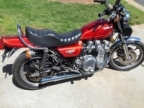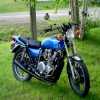Final exam for 'Valve Clearance 101 class'
- janwic
-
Topic Author
- Offline
- User
-

Registered
- Posts: 6
- Thanks: 0
Final exam for 'Valve Clearance 101 class'
07 Jun 2006 15:16
Hi,
I've been searching for posts re valve clearance and its associated problems, and I believe it is time to summarize what I've picked up so far:
Gentlemen, please help me out with the answers here. My bike is due for some service at the shop next week (shimming is not my cup of tea) and I would appreciate some advice on what to tell him. Out of the eight valves, I managed to get a .05 gauge under only one of them, and that is the thinnest one I've got. The bike runs well under heavy throttle but it fires a lot during downshifting, and I put my hope to the valves since I cared for about everthing else.
I've been searching for posts re valve clearance and its associated problems, and I believe it is time to summarize what I've picked up so far:
- You need to adjust the valves every once in a while, because valve clearances tend to reduce over time, right?
- when a valve clearance gets very small (less than .05 mm = .002 inches on my KZ1100D) I can expect strange things to happen such as less power, backfiring etc
- when you lap a valve seating, clearance is reduced
- when valve clearance is large you can expect much valve noise, as the cam lobes hit the shims from far off. But doesn't that influence valve timing as well, leaving the valves open during a smaller part of the engine revolutions?
- So, if the specified interval of valve clearance is .05-.15 mm (as is the case for my bike) the bike is better off if I aim as close as .05 as possible?
- As it is time consuming to shift the shims, I can expect a shop mechanic to allow clearances under .05 perhaps arguing that it reduces valve noise
- When I complained about my mechanic leaving the clearances too small the last time I let him service my bike, he said that the proper way to measure isn't opposite each cam lobe, but 'all around' and that explains the differences in measure. Shall I accept that?
Gentlemen, please help me out with the answers here. My bike is due for some service at the shop next week (shimming is not my cup of tea) and I would appreciate some advice on what to tell him. Out of the eight valves, I managed to get a .05 gauge under only one of them, and that is the thinnest one I've got. The bike runs well under heavy throttle but it fires a lot during downshifting, and I put my hope to the valves since I cared for about everthing else.
Please Log in or Create an account to join the conversation.
- ltdrider
-

- Offline
- User
-

Registered
- Posts: 1232
- Thanks: 18
Re: Final exam for 'Valve Clearance 101 class'
07 Jun 2006 16:03
I can't help with all of this, but...
You need an accurate measurement of the clearance. On my 900, the maual requires that a mark on the camchain pulley be lined up the the surface of the head. Then you can measure the cams that are gapped. But when the pulley mark is lined up, the lobes are NOT directly opposite of the buckets.
The 900 Manual says the correct clearance is .002 - .004 inches, or .05 to .10 mm. Don't forget, the motor has to be cold.
There's lots of opinions among the riders as to where in the range the clearance should be set. I think some like a little more clearance on the exhaust side.
You need an accurate measurement of the clearance. On my 900, the maual requires that a mark on the camchain pulley be lined up the the surface of the head. Then you can measure the cams that are gapped. But when the pulley mark is lined up, the lobes are NOT directly opposite of the buckets.
The 900 Manual says the correct clearance is .002 - .004 inches, or .05 to .10 mm. Don't forget, the motor has to be cold.
There's lots of opinions among the riders as to where in the range the clearance should be set. I think some like a little more clearance on the exhaust side.
'76 KZ900 LTD (Blaze)
'96 Voyager XII (Dark Star)
'79 KZ650 Cafe Project (Dirty Kurt)
Greensboro, NC
'96 Voyager XII (Dark Star)
'79 KZ650 Cafe Project (Dirty Kurt)
Greensboro, NC
Please Log in or Create an account to join the conversation.
- Duck
-

- Offline
- User
-

Registered
- e vica na i sau na ga
- Posts: 1267
- Thanks: 35
Re: Final exam for 'Valve Clearance 101 class'
07 Jun 2006 16:17
janwic wrote:
-Duck
when it gets so small that the valve doesn't seat at operating temp you can expect reduced performance and eventually damage.Hi,
I've been searching for posts re valve clearance and its associated problems, and I believe it is time to summarize what I've picked up so far:
- when a valve clearance gets very small (less than .05 mm = .002 inches on my KZ1100D) I can expect strange things to happen such as less power, backfiring etc
yeswhen you lap a valve seating, clearance is reduced
that's the reason for the upper limit.when valve clearance is large you can expect much valve noise, as the cam lobes hit the shims from far off. But doesn't that influence valve timing as well, leaving the valves open during a smaller part of the engine revolutions?
the drag guy I talked to all said 0.006 inch. I shoot for 0.004 inch and do not drag.So, if the specified interval of valve clearance is .05-.15 mm (as is the case for my bike) the bike is better off if I aim as close as .05 as possible?
measure and swap if wrong. the time it takes is the time it takes. Did a friends Honda cb750 the other day in 30 minutes.As it is time consuming to shift the shims, I can expect a shop mechanic to allow clearances under .05 perhaps arguing that it reduces valve noise
accepted practice seems to be measuring clearance where it's the greatest.When I complained about my mechanic leaving the clearances too small the last time I let him service my bike, he said that the proper way to measure isn't opposite each cam lobe, but 'all around' and that explains the differences in measure. Shall I accept that?
If you can spin the shim off lobe, you've still got some clearance. If you want to measure it accurately, spend $10-$15 for some good feelers with bent, ground, tips. Tell your mechanic what you measured. Tell him what the bike is doing. Ask him what he thinks. IME backfire on deceleration = air leak. I've only been wrenching bikes a year, and only as a hobby, so take this all with a grain of salt.
Gentlemen, please help me out with the answers here. My bike is due for some service at the shop next week (shimming is not my cup of tea) and I would appreciate some advice on what to tell him. Out of the eight valves, I managed to get a .05 gauge under only one of them, and that is the thinnest one I've got. The bike runs well under heavy throttle but it fires a lot during downshifting, and I put my hope to the valves since I cared for about everthing else.
-Duck
Please Log in or Create an account to join the conversation.
- 1045
-
- Offline
- User
-

Registered
- Posts: 114
- Thanks: 3
Re: Final exam for 'Valve Clearance 101 class'
07 Jun 2006 18:21
Duck got them all right....
Shim for max clearance (.006") as they will close up over time
1045
Shim for max clearance (.006") as they will close up over time
1045
1045
Please Log in or Create an account to join the conversation.
- Trav
-
- Offline
- User
-

Registered
- Posts: 121
- Thanks: 0
Re: Final exam for 'Valve Clearance 101 class'
07 Jun 2006 21:07
Personally, I shoot for max clearances. Mainly because of what 1045 said. They give a range for a reason, and unless you are strickly running a drag racer, I wouldn't worry about .006" vs .008" clearance (my bike is .004" - .008" intake and .006" - .010" exhaust for where I'm coming from) I really don't know how much a couple thousands effects performance, but obviously you can go a few more, and a few more and then eventually the valve is stuck open so the line gets drawn somewhere, to keep it performing properly, and not making too much noise or bouncing a shim loose.
Anyway, I shoot for the max clearance, because the clymer gives you some somewhat mind teasing math to do in which you use the measured clearance, the shim size, and the desired clearance to figure what new shim you should use. I always go for the max, and usually end up a thousandth under, sometimes right on it. I must not get my cams lobes 100% where they need to be or something.. or round the wrong way. Sometimes one valve might come out a tight .007" and another might be a loose .007", but neither will fit .008". A shim size smaller for both, and one might still be .007" now loose and the other .006"
I've only done it twice but I found the prediction vs real-world testing to be a bit off. Once you get the cams in, timed and torqued, it's usually like "Ok, within 1 or 2 thou of max? lets do it.
Actaully I have a good question! not to hi-jack or anything, but is there an accelerated change in valve clearance immediately after a valve job? I know the job itself changes things, but I mean after you get them set, do the valves 'wear in' and change a few thousands pretty quickly before they settle in?
Anyway, I shoot for the max clearance, because the clymer gives you some somewhat mind teasing math to do in which you use the measured clearance, the shim size, and the desired clearance to figure what new shim you should use. I always go for the max, and usually end up a thousandth under, sometimes right on it. I must not get my cams lobes 100% where they need to be or something.. or round the wrong way. Sometimes one valve might come out a tight .007" and another might be a loose .007", but neither will fit .008". A shim size smaller for both, and one might still be .007" now loose and the other .006"
I've only done it twice but I found the prediction vs real-world testing to be a bit off. Once you get the cams in, timed and torqued, it's usually like "Ok, within 1 or 2 thou of max? lets do it.
Actaully I have a good question! not to hi-jack or anything, but is there an accelerated change in valve clearance immediately after a valve job? I know the job itself changes things, but I mean after you get them set, do the valves 'wear in' and change a few thousands pretty quickly before they settle in?
Please Log in or Create an account to join the conversation.
- letthegoodtimesroll
-

- Offline
- User
-

Registered
- Posts: 162
- Thanks: 1
Re: Final exam for 'Valve Clearance 101 class'
08 Jun 2006 04:07
What type of gauge do you use to measure the thickness of the shims? I used a set of calipers that measured the thickness to approx 3.5mm. How does this transfer to the actual size of the shim?
1977 KZ650C1, Kerker Header, Dyna ignition and coils, GPZ 750 oil pan and cooler
Please Log in or Create an account to join the conversation.
- Duck
-

- Offline
- User
-

Registered
- e vica na i sau na ga
- Posts: 1267
- Thanks: 35
Re: Final exam for 'Valve Clearance 101 class'
08 Jun 2006 04:44
The spec is 0.05mm to 0.15mm. If a 0.002" feeler fits and a 0.006" doesn't, then it's within spec. If not then I shoot for 0.004" because it's the middle of the target. It's not important enough to muck around with all day...
Please Log in or Create an account to join the conversation.
- wiredgeorge
-

- Offline
- User
-

Registered
- Posts: 5309
- Thanks: 45
Re: Final exam for 'Valve Clearance 101 class'
08 Jun 2006 05:40
I will NOT explain valve clearance stuff yet again... it is written up on my web site if you are interested:
www.wgcarbs.com/269767.html
www.wgcarbs.com/269767.html
wiredgeorge Motorcycle Carburetors
Mico TX
www.wgcarbs.com
Too many bikes to list!
Mico TX
www.wgcarbs.com
Too many bikes to list!
Please Log in or Create an account to join the conversation.
- BARNEYHYPHEN
-
- Offline
- User
-

Registered
- Posts: 419
- Thanks: 1
Re: Final exam for 'Valve Clearance 101 class'
08 Jun 2006 11:08
LTGTR, on the 900, a "250" shim should be 2.50mm thick. Likewise, a "285" shim should be 2.85mm.
1mm = 39.37(ish) thou and we tend to use imperial (thou) to measure our clearances. Difference in standard shim sizes are approx 2 thou.
So, what I did is I "miced" each and every shim I had, stuck a small piece of masking tape on each one and wrote the "thou" thickness on the tape. You'd be surprised how 3 or 4 "250" shims can be as much as a thou+ different from each other.
So, when I'm using say a 285 shim but the feeler is too sloppy and a 290 closes the gap too much, I look for a "heavy" (or slightly thicker) 285.
Hope this all helps?
1mm = 39.37(ish) thou and we tend to use imperial (thou) to measure our clearances. Difference in standard shim sizes are approx 2 thou.
So, what I did is I "miced" each and every shim I had, stuck a small piece of masking tape on each one and wrote the "thou" thickness on the tape. You'd be surprised how 3 or 4 "250" shims can be as much as a thou+ different from each other.
So, when I'm using say a 285 shim but the feeler is too sloppy and a 290 closes the gap too much, I look for a "heavy" (or slightly thicker) 285.
Hope this all helps?
Please Log in or Create an account to join the conversation.
- nads.com
-
- Offline
- User
-

Registered
- Posts: 995
- Thanks: 20
Re: Final exam for 'Valve Clearance 101 class'
08 Jun 2006 23:05
Ive measured on a deg. wheel. ( you get bored) THE difference in op. and cl. numbers when less than .002 is used. Then valve opens Around 5deg. early and closes 5 or more deg. later. I did this time and time and again. Hey, i had cams on the way! Ive ran anywhere from .001 on some and .012 on others and i couldnt tell the diff. BUT, theres moore! Then compression tested at 170 and 180 on two cylinders, 224 on the other. I checked clearance and found the lower reading cylindrs had .001. The others .004 or more. I set all to at least four and then had 224 across. Run a big jet and use colder plugs and walaa, carbon builds up and compression goes to 224. It didnt have any more power though. To get rid of the carbon: change plugs back to proper heat range, neat huh. Narrow clearnaces increase the duration the valves are open and extends power band higher. There is no extra power gain because compression drops. If you run 10-1 and cant afford cams and are crazy, set clearances tight. It really doesnt take much beer. That little wheel is really cool. Tells u who's cheating hoo whose whoo, stories of whinne the poo,i spun it twice and ...... aww never mind. Its never lied anyway. It cant. APE did something to it.
Please Log in or Create an account to join the conversation.
Moderators: Street Fighter LTD

